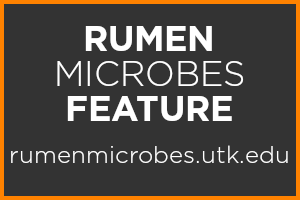
In honor of a great year at rumenmicrobes.utk.edu and all the microbes featured, we’ve developed this interactive collage of all the microbes from 2019. Click or hover on the image hotspots to see them all, or visit each presentation in the link provided.
Please click on the image hotspots to learn more about 2019 features.

Learn more
Escherichia coli
This past year we learned about Escherichia coli or best known as E. coli. This bacterium is found in great abundance in the lower gastrointestinal tract, specifically the mucosal surface of the rectum. Cattle populations are known reservoirs for certain pathogenic E. coli, and are typically asymptomatic carriers of the organism. However, most strains of E. coli are not harmful but are part of the normal bacterial communities of the gut. View the interactive presentation.
Learn more
Butyrivibrio fibrisolvens
Another highlighted feature was Butyrivibrio fibrisolvens. This curved, rod-shaped bacterium has a high capacity to produce butyrate, which plays an important role in the physiology and metabolism of the intestine and its tissues. View the interactive feature.
Learn more
Clostridium spp
In July, Taylor Seay discussed Clostridium species. These are rod-shaped, gram-positive, anaerobic bacteria commonly found in the gastrointestinal tract of ruminants. Clostridium species have also been found to be abundant in the vagina of cows due to its opening to the environment, close proximity to the digestive tract, and exposure to feces. Although abundant in the vagina of cows, Clostridia abundances are lower in the uterus, potentially due to the cervix providing a protective barrier from pathogen entry. View the interactive presentation.
Learn more
Ureaplasma spp.
August's featured microbe included the species of the genus Ureaplasma. These microbes are one of two important types of bacteria of the bacterial group called Mollicutes. The name Mollicutes – soft skin – reveals the major mutual characteristic of these bacteria which is the lack of a cell wall. Ureaplasma can be found in the rumen as well as the reproductive tract. When present in the semen of bulls, it can lead to poor fertility and embryo loss. View the interactive presentation.
Learn More
Eubacterium collulosolvens
September permitted us to examine Eubacterium cellulosolvens. This is an anaerobic, peritrichous (having flagella all over its surface) bacterium. It is primarily known for its cellulolytic activity in ruminants, however, it is also present in the digestive tract of other species of animals when fed diets high in cellulose. While originally it was thought to be a relatively insignificant member of the microbial community in the rumen, new research has led to potential discoveries about its purpose as well as useful properties in other fields. View the interactive presentation.
Learn More
Trueperella pyogenes
Finally, In October, we learned about Trueperella pyogenes (formerly known as Actinomyces pyogenes and Arcanobacterium pyogenes). T. pyogenes is found in the rumen, but is also identified acting as a pathogen in the liver and reproductive tract. It has been found to act synergistically with Fusobacterium necrophorum in causing liver abscesses in cattle. T. pyogenes is often isolated from postpartum uterine infections, such as endometritis or metritis, which are associated with reduced fertility. View the interactive presentation.
Follow this link to view all of the interactive presentations for the Rumen Microbes series.